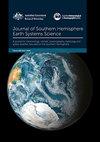澳洲日雨量分布及模拟未来变化
IF 3.6
4区 地球科学
Q1 Earth and Planetary Sciences
引用次数: 0
摘要
本研究通过分析日降雨量的全频率分布,并对新的统计数据湿润日分数和雨的最高百分位数进行预测,扩展了最近对澳大利亚月和日降水的预测。采用了33个CMIP5模式的综合模拟和6个降尺度模式CCAM的模拟,并对模型网格上的数据进行了分析。CCAM具有更高的分辨率(0.5°),与大多数CMIP5模式相比,CCAM能更好地模拟极端格点降水。CCAM与AWAP网格数据的湿日分数比较好,而CMIP5的结果差异较大。在RCP8.5情景下的2080-2099年的未来气候中,CMIP5集合中大多数地区和季节的平均降雨量都发生了这两种迹象的变化,尽管在大多数模式和CCAM中,南澳大利亚的平均冬季降雨量下降了5%至30%。与CMIP5相比,CCAM模拟了夏季的增加,以及更多的潮湿天气。除了冬季的北方,CMIP5的变化变得越来越正,从平均到最高百分位数到20年极端降雨量,反差通常为25%。CCAM的这些统计数据之间的反差要小得多。降雨量的分布揭示了这些不同的预估。在澳大利亚和四个季节平均,CCAM产生比CMIP5总体平均值更广泛的分布。然而,未来增加的大部分是在2至8毫米的日范围内,而CMIP5的分布倾向于在30毫米至200毫米的范围内转移。建议对这些发行版以及更新版本的CCAM、ACCESS和其他gcm进行进一步评估。本文章由计算机程序翻译,如有差异,请以英文原文为准。
The distribution of daily rainfall in Australia and simulated future changes
This study extends recent projections of monthly and daily precipitation over Australia by analysing the full frequency distribution of daily rain amounts and making projections of the new statistics wet-day fraction and top percentile of rain. Simulations from an ensemble of 33 CMIP5 models are used, together with six simulations from the downscaling model CCAM, with the data analysed on the model grids. Consistent with its higher resolution (0.5°), CCAM provides a more skilful simulation for the extreme grid point rainfall than most CMIP5 models. CCAM compares well with AWAP gridded data for wet-day fraction, while there is a wide range of CMIP5 results. In the future climate of 2080–2099 under the RCP8.5 scenario, changes in mean rainfall of both signs occur within the CMIP5 ensemble for most regions and seasons, although mean winter rainfall in southern Australia declines 5 to 30 per cent in most models and in CCAM. CCAM simulates increases in summer, and also more wet days, in contrast to CMIP5. Aside from the north in winter, the changes from CMIP5 become increasingly positive, on stepping from mean to top percentile to twenty-year extreme rainfall, a contrast of typically 25 per cent. There is much less contrast between these statistics from CCAM. The distributions of rain amounts shed light on these different projections. Averaged over Australia and four seasons, CCAM produces a broader distribution than the CMIP5 ensemble mean. However much of the future increase is in the 2 to 8 mm daily range, whereas CMIP5 distributions tend to shift towards amounts in the range 30 mm to 200 mm. Further assessment of such distributions in both these and newer versions of CCAM, ACCESS and other GCMs is recommended.
求助全文
通过发布文献求助,成功后即可免费获取论文全文。
去求助
来源期刊

Journal of Southern Hemisphere Earth Systems Science
Earth and Planetary Sciences-Oceanography
CiteScore
8.10
自引率
8.30%
发文量
0
审稿时长
>12 weeks
期刊介绍:
The Journal of Southern Hemisphere Earth Systems Science (JSHESS) publishes broad areas of research with a distinct emphasis on the Southern Hemisphere. The scope of the Journal encompasses the study of the mean state, variability and change of the atmosphere, oceans, and land surface, including the cryosphere, from hemispheric to regional scales.
general circulation of the atmosphere and oceans,
climate change and variability ,
climate impacts,
climate modelling ,
past change in the climate system including palaeoclimate variability,
atmospheric dynamics,
synoptic meteorology,
mesoscale meteorology and severe weather,
tropical meteorology,
observation systems,
remote sensing of atmospheric, oceanic and land surface processes,
weather, climate and ocean prediction,
atmospheric and oceanic composition and chemistry,
physical oceanography,
air‐sea interactions,
coastal zone processes,
hydrology,
cryosphere‐atmosphere interactions,
land surface‐atmosphere interactions,
space weather, including impacts and mitigation on technology,
ionospheric, magnetospheric, auroral and space physics,
data assimilation applied to the above subject areas .
Authors are encouraged to contact the Editor for specific advice on whether the subject matter of a proposed submission is appropriate for the Journal of Southern Hemisphere Earth Systems Science.
 求助内容:
求助内容: 应助结果提醒方式:
应助结果提醒方式:


